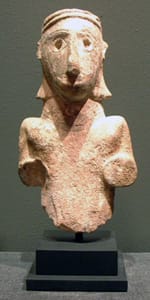Sabean Stone Bust of a Man, 1st Century CE
Stone
X.0208
Further images
The ancient kingdom of Saba ruled over the lands of southern Arabia, centered in modern day Yemen. Saba is perhaps better known as Sheba, the Hebrew word for the kingdom,...
The ancient kingdom of Saba ruled over the lands of southern Arabia, centered in modern day Yemen. Saba is perhaps better known as Sheba, the Hebrew word for the kingdom, whose famous Queen was recounted as having visited Solomon in the pages of the Old Testament. Biblical accounts speak of the wealth of this ancient civilization of traders and merchants, and modern archaeological excavations confirm these reports. Ruins of fortresses and walled towns are evident and remnants of their extensive irrigation system that turned the desert into a paradise still cover the land. Although gold and silver deposits were present, the chief source of their vast wealth was derived from their veritable monopoly of two of the most coveted materials in ancient times: frankincense and myrrh, resinous gums obtained from certain trees that only grow in Southern Arabia and were literally worth their weight in gold. There was not a temple or wealthy house in the ancient world, from Babylon to Rome, where one would not smell the fragrant scents of these incenses. In addition, a trade route that connected India to Egypt that passed through their capital of Marib was another major source of wealth. Perhaps their greatest accomplishment was the Great Dam of Marib, a monumental construction that brought water from the mountains both to the city and to the crop fields. The dam was in continual use (accounting for timely repairs) until the 6th Century A.D. and its ultimate destruction is detailed in the Koran as the end of the old world and a turning point in history. However, the civilization that created this wonder fell apart long before the damn did. In the 1st Century A.D., the Ptolemaic Greeks discovered a sea route from India directly to the port of Alexandria, eliminating Saba from this lucrative trade and ushering in the decline of Sabean prosperity.
This magnificent stone bust of a young man is but one example of the magnificence of Sabean art. He has large eyes that were likely once inlaid with precious stones or glass in order to heighten the sense of naturalism, a long nose, and a small, slightly smiling mouth. The texture of his hair has been indicated by finely incised lines. Similar fine lines also indicate that he is wearing a necklace or sorts. The naturalistic rendering of the features betrays a Roman influence present in South Arabia at the time.
This magnificent stone bust of a young man is but one example of the magnificence of Sabean art. He has large eyes that were likely once inlaid with precious stones or glass in order to heighten the sense of naturalism, a long nose, and a small, slightly smiling mouth. The texture of his hair has been indicated by finely incised lines. Similar fine lines also indicate that he is wearing a necklace or sorts. The naturalistic rendering of the features betrays a Roman influence present in South Arabia at the time.









